The World’s Fastest Narrow-Gauge Trains
RAILWAYS OF THE WORLD - 6
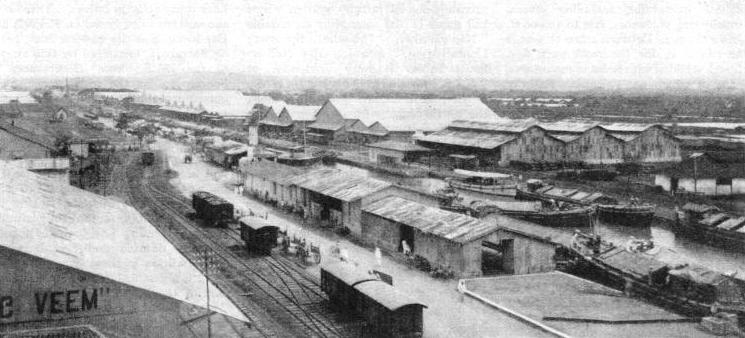
THE RAILWAY TERMINUS of the port of Semarang, situated on the north coast of Java. The terminus is served by the Netherlands Indies Railway Company. Express trains connect Batavia, the capital, with this port.
TWO large railway systems vie with one another for the distinction of working the fastest trains in the world over narrow-gauge lines. One of them is the network of the Japanese Government Railways, all laid on a gauge of 3 ft 6-in. With the well-known enterprise of the Japanese, it might readily be understood that Japan would take a leading position in this respect. But the locality of the other competitor might not have been so easily guessed. It is the Dutch island of Java, in the East Indies. Furthermore, the Netherlands East India State Railways, to give them their full title, take the lead. Over their narrow-gauge tracks, also 3 ft 6-in in width, there are express train schedules in force from start to stop at nearly fifty miles an hour. Also maximum speeds up to and exceeding sixty miles an hour are common.
The island of Java forms a part of the extensive and important Dutch possessions in the East Indies, which total 750,000 square miles in area and nearly 61,000,000 in population. In Java some 42,000,000 people find a home. Indeed, it is more densely populated than any European country, including Belgium, because all this population is concentrated in an island 622 miles long, varying in width from 60 to 120 miles, and having an area of 48,504 square miles. In many ways Java has reached a very forward state of development, which helps to explain why its railways are so advanced. The building of good roads and the opening up of air services in various directions, too, have encouraged the railway authorities, as in so many other countries, to speed up the trains to the utmost possible limit, in order to fight this competition. Including the railways in Sumatra, Borneo, and Celebes, 4,617 miles of line, of different gauges and belonging to various owners, have been laid in the Dutch East Indian colonies. In Java alone the State railway mileage is 1,844.
The two largest cities in Java - Batavia and Soerabaja - are situated near the extreme western and eastern extremities of the island respectively. These two ends are mountainous, the western end in particular, which consists of a high tableland known as the Preanger country, averaging about 2,500 ft above sea-level. Its highest mountains, including several smouldering volcanoes, rise to 12,000 ft above the sea. Between these two ends the island is, for the most part, flat, though studded with isolated mountains, many of which are volcanic. Railway engineering through the centre of the island has, therefore, been a more or less easy matter, though it includes many big bridges over streams which at times develop into wide and angry torrents. But there are some steep gradients, sharp curves, and other evidences of difficult engineering on the important lines through the mountainous country at the western end of the island of Java.
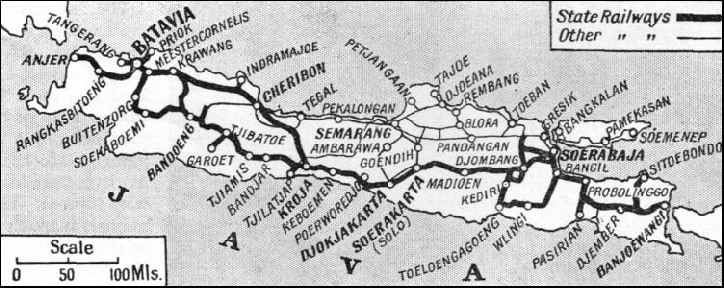
1,844 MILES OF TRACK, owned by the State, serve Java’s population of 42,000,000. There are also private lines. The above map shows the chief routes and towns served.
In the middle of Java there is a privately-owned railway system whose full name is the somewhat formidable “Nederlandsch Indische Spoorweg Maatschappij”, meaning the Netherlands Indies Railway Company, or “N.I.S.” for short. This has its centre in the port of Semarang, midway along the north coast, with direct main line running eastwards to Soerabaja and other lines southwards to Soerakarta and Djokjakarta. The former are on the 3 ft 6-in gauge, similar to the State lines, but the latter - comprising the original N.I.S. system - are on a gauge of 4 ft 8½-in.
The interesting part of this latter system, in the middle of the island, is that for some years it cut the State lines completely in halves. There were the western lines, based on Batavia and Bandoeng, and the eastern lines, based on Soerabaja, separated by this stretch of the N.I.S., from Djokjakarta to Soerakarta, on the wider gauge, a circumstance that necessitated a double transhipment of both passengers and freight. At last, by an amicable arrangement between both railway managements, “mixed” gauge was laid along “The Connection” as it is known - three rails, that is to say, with the 3 ft 6-in gauge inside the 4 ft 8½-in; and from that time onwards through running has become possible between Batavia and Soerabaja.
In addition to these two trunk lines, there is a ramified system, on the north side of the island, of privately-owned “Stoomtrani Maatschappijen”, which means literally “steam tramway companies”. But so highly developed are those so-called “tramways” nowadays, that they boast express trains, through coaches between Batavia and Semarang, and even restaurant cars.
It is on the main line between Batavia and Soerabaja that the highest speeds in Java are run. Until after the war of 1914-1918, although the two cities are little more than 500 miles apart, it was not possible to complete the journey from one to the other in a single day. One peculiarity of railway operation in Java is that no trains are run after dark, owing to the risk of running over unfenced lines, and to the dangers from landslides and tropical rains. All trains, of whatever description, cease to operate between 6 and 7 o’clock in the evening. So much time in earlier days had to be spent in running over the steep gradients in the Preanger country, through Bandoeng, that it was necessary to stay overnight at Bandoeng or Djokjakarta, and then to resume the journey on the following day. It thus took 28½ or 29 hours to travel from Batavia to Soerabaja.
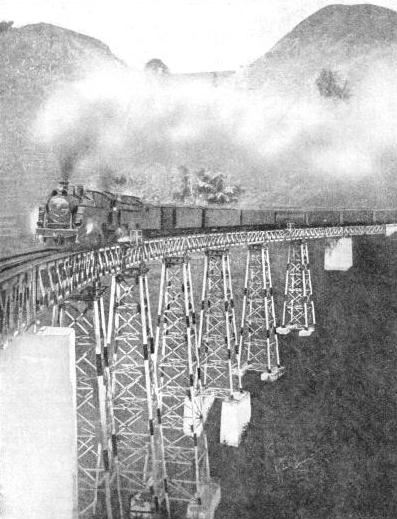 The hazards of train operation in a country such as Java are well illustrated by the fact that a water buffalo once strayed on to the main line near Batavia. This was at a point where the track crosses a river and the animal caused so disastrous a derailment - the train plunged into the stream - that twenty-five lives were lost, and eighty passengers were injured. The fact that one of these animals is much bigger than his English relation, and that the rolling-stock, on the other hand, is comparatively light to English standards, helps to explain the seriousness of this accident.
The hazards of train operation in a country such as Java are well illustrated by the fact that a water buffalo once strayed on to the main line near Batavia. This was at a point where the track crosses a river and the animal caused so disastrous a derailment - the train plunged into the stream - that twenty-five lives were lost, and eighty passengers were injured. The fact that one of these animals is much bigger than his English relation, and that the rolling-stock, on the other hand, is comparatively light to English standards, helps to explain the seriousness of this accident.
CROSSING A VIADUCT in the Preanger Mountains. To reach Bandoeng from Batavia the train has to ascend gradients as steep as 1 in 45.
After the Great War a new line was constructed linking Cheribon, on the north coast, where the island is at its narrowest, with Kroja, on the south side. Thus a new and shorter route was created along the length of the island. Between Proepoek and Kroja, where the line crosses the backbone of the island, the maximum altitude of 1,614 ft is reached, by dint of a hard pull up from both sides; but otherwise the main trunk line is now fairly level throughout.
The result of opening this new link was to cut down the quickest train time for the Batavia-Soerabaja journey from 28½ or 29 hours to 13 hours for the 512 miles, and for the first time to enable the whole of it to be completed between sunrise and sunset.
Since then the time has come down to 12 hours 20 minutes, which entails an average speed of 41.5 miles an hour inclusive of a dozen intermediate stops, and the climb over the summit which has just been mentioned.
Over the flat stretches of the line some of the train timings, both in the matter of long-distance running and of speed, are world records over narrow-gauge track. Starting from the Weltevreden Station at Batavia, the Batavia-Soerabaja “Limited” makes a non-stop run of over one hundred miles - 133.5 miles, to be precise - to Cheribon, and does the whole distance in less than three hours. Eastbound the time allowed is 173 minutes, and westbound 171 minutes, which works out at 46.8 miles an hour from start to stop. Slightly faster timings than these are in force between Cheribon and Proepoek, and between Soerakarta and Madioen. The last-named stretch of 60.8 miles is run in 77 minutes, at 47.4 miles an hour, and .this is the fastest run in the island, requiring maximum speeds as high as a mile-a-minute for punctuality; it is also the fastest booked run in the world over either 3 ft 6-in or metre gauge. Another very long run without a stop is between Kroja and Djokjakarta, a distance of 87 miles.
Long Non-Stop Runs
As compared with the coaches used, say, in Great Britain, those employed in Java are, as previously mentioned, light, but travellers in that country unite in paying tribute to the smoothness of the running, despite the narrow gauge, at these high speeds. The “Limited” express comprises about half a dozen passenger coaches, with a restaurant car, and is worked by up-to-date “Pacific” locomotives, some built in Holland and others in Switzerland, designed for working 300-ton trains at sixty miles an hour. Certain of these are two-cylinder simple locomotives, and the remainder are four-cylinder compounds. Large eight-wheeled tenders are carried, so that sufficient water and fuel can be accommodated on these non-stop runs.
But over some of the mountainous-sections in the interior of the island working the trains is a much more difficult matter. Among the Preanger Mountains, at the west end, there are some remarkable features about the engineering of the various lines which connect up the principal towns. The old main line, which was used by the Batavia-Soerabaja through trains before the opening of the Cheribon-Kroja cut-off, leaves the Cheribon line at Tjikampek, and turns southwards. At Poerwakarta the climb into the mountains begins, and a powerful Mallet-type locomotive takes charge of the train.
As will be explained in a chapter on Unconventional Locomotives, Mallet engines are of an articulated type, somewhat resembling the Garratt type,. with two independent sets of cylinders and motion at the two ends of the engine, on independent chassis, each of which has freedom to swing round the curve. But instead of the two chassis being connected by a girder frame which. carries the boiler, a Mallet locomotive has the boiler mounted immediately above the wheels; the two chassis are therefore comparatively close together,. and the engine as a whole is considerably shorter than a Garratt. Further, compound propulsion is used, the high pressure cylinders being mounted on one chassis, and the low-pressure cylinders on the other.
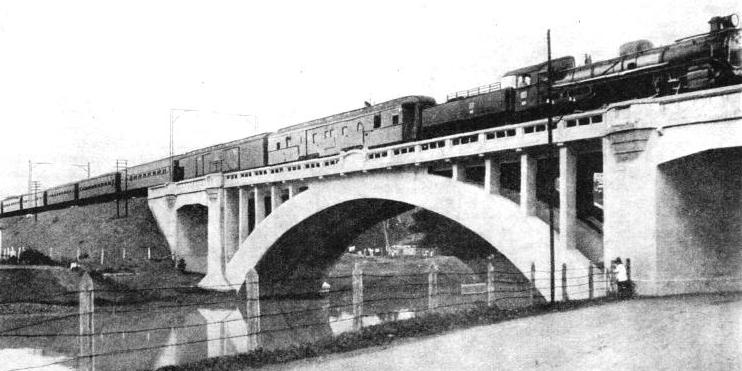
ON THE MAIN LINE. The Batavia-Djokja express crossing a concrete viaduct near the Weltevreden Station.
Various types of Mallet compounds are used in Java, but the particular variety which takes over the Bandoeng trains is the latest of the 2-8 + 8-0 type - that is, with two independent sets of eight-coupled wheels, and a leading pair of idle wheels at the chimney end. These engines have double chimneys, and are up-to-date in their equipment. Some of them were built in America and others in Holland. They are sufficiently powerful to handle 1,500-ton freight trains up continuous 1 in 60 gradients. At Padalarang this line is joined by another main route which has pursued a circuitous course from Batavia by way of Buitenzorg. Over the steep gradients between Buitenzorg and Bondoeng Mallet tank locomotives of the 2-6 + 6-0 type are used. Occasionally, when the trains are heavy, two of these may be attached to the same train, which is then provided with motive power to the extent of twenty-tour pairs of coupled wheels.
Onwards to the east from Bandoeng, important connecting trains are run, in place of the original main line service, to link up with the Batavia-Soerabaja expresses at Kroja. This is the most difficult section of main-line track in Java. From Bandoeng 4-6-4 tank locomotives work the express trains to Tjitjalenka, whence a Mallet compound takes charge to Bandjar.
This route, through the mountains, is in places as steep as 1 in 40, and constantly winds, with very sharp curves, that explain the preference of the railway management for articulated locomotives. It was once worked by some unique tank locomotives having no fewer than six axles coupled - of the 2-12-2 type - but the wear of the rails on the curves by reason of their long coupled wheelbase became so serious that Mallet locomotives were substituted, and this wear has since been greatly reduced.
Modern Developments
Many remarkable steel viaducts have also been thrown across the ravines in this wild country, but tunnelling, on the other hand, appears to have been successfully avoided, as in the whole of the island there are only four short tunnels.
Midway between Bandoeng and Bandjar is Tjibatoe, from which a branch runs southwards to Garoet, in the heart of the volcanic region, and now extended to Tjikadjang, which is 4,000 ft above the sea. There are long inclines at 1 in 26 on this branch. Between Tjibatoe and Bandjar, the main line from Bandoeng to Soerabaja falls 1,900 ft in sixty miles.
Bandoeng, a local capital, is 2,332 ft above sea-level: here are situated the headquarters offices of the railway administration. These include a signalling school for the employees; it is partly due to the up-to-date signalling equipment of the main lines that the high speeds of the railways in Java have been made possible. Other contributory factors are the excellence of the track and its high standard of maintenance; the rails used weigh 81 lb to the yard. Locomotive axle loads are not permitted to exceed from twelve to fifteen tons per axle, and this also helps to explain the popularity of Mallet locomotives, which spread the tractive force of a powerful locomotive over a large number of axles.
Reference has already been made to the fact that electric trains have come into use round the city of Batavia, which has about 440,000 inhabitants. Included in the electrification scheme is first the “Ringbaan”, or “Circle Railway”, coming up from the port of Tandjongpriok through Pasarsenen to Meestercornelis, with a branch from Kemajoran into the main station at Batavia; over this a service is run at fifteen-minute intervals from dawn to dusk.
Another route, with half-hourly trains, connects Tandjongpriok with the important station of Weltevreden, from which the express trains start for Bandoeng and Soerabaja, and with Manggarai and Meestercornelis. And now the electrification has been carried up through the lulls, over 1 in 50 gradients, to Buitenzorg, the seat of the Governor-General of the Netherlands East Indies, and, owing to its cool climate, a popular place of residence for Government officials. Buitenzorg is also notable as possessing one of the most famous botanical gardens in any part of the world. The distance is just over thirty-one miles from Batavia, and despite the severe ascent which has to be negotiated, the quickest electric trains have now brought Buitenzorg within forty-eight minutes of Batavia. Mainline trains from Batavia to Bandoeng by way of Buitenzorg are hauled by electric locomotives over this stage of the journey - an arrangement which effects considerable time-saving.
Java possesses the most progressive railway system in the tropics, and one of the world’s most efficient narrow-gauge railway networks.
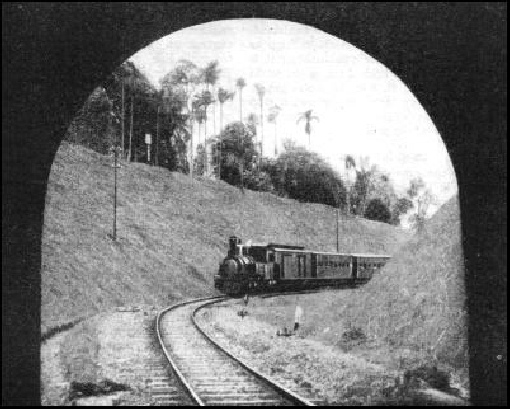
A PASSENGER TRAIN about to enter a tunnel near Tjitjoeroeg, on the Netherlands Indies Railway Company’s line. The single track will be noticed; all main lines in Java, except those in the vicinity of Batavia, are single track.
You can read more on “Island Railways”, “Rail Transport in Ceylon” and “Trains in Siam” on this website.





 The hazards of train operation in a country such as Java are well illustrated by the fact that a water buffalo once strayed on to the main line near Batavia. This was at a point where the track crosses a river and the animal caused so disastrous a derailment -
The hazards of train operation in a country such as Java are well illustrated by the fact that a water buffalo once strayed on to the main line near Batavia. This was at a point where the track crosses a river and the animal caused so disastrous a derailment -
